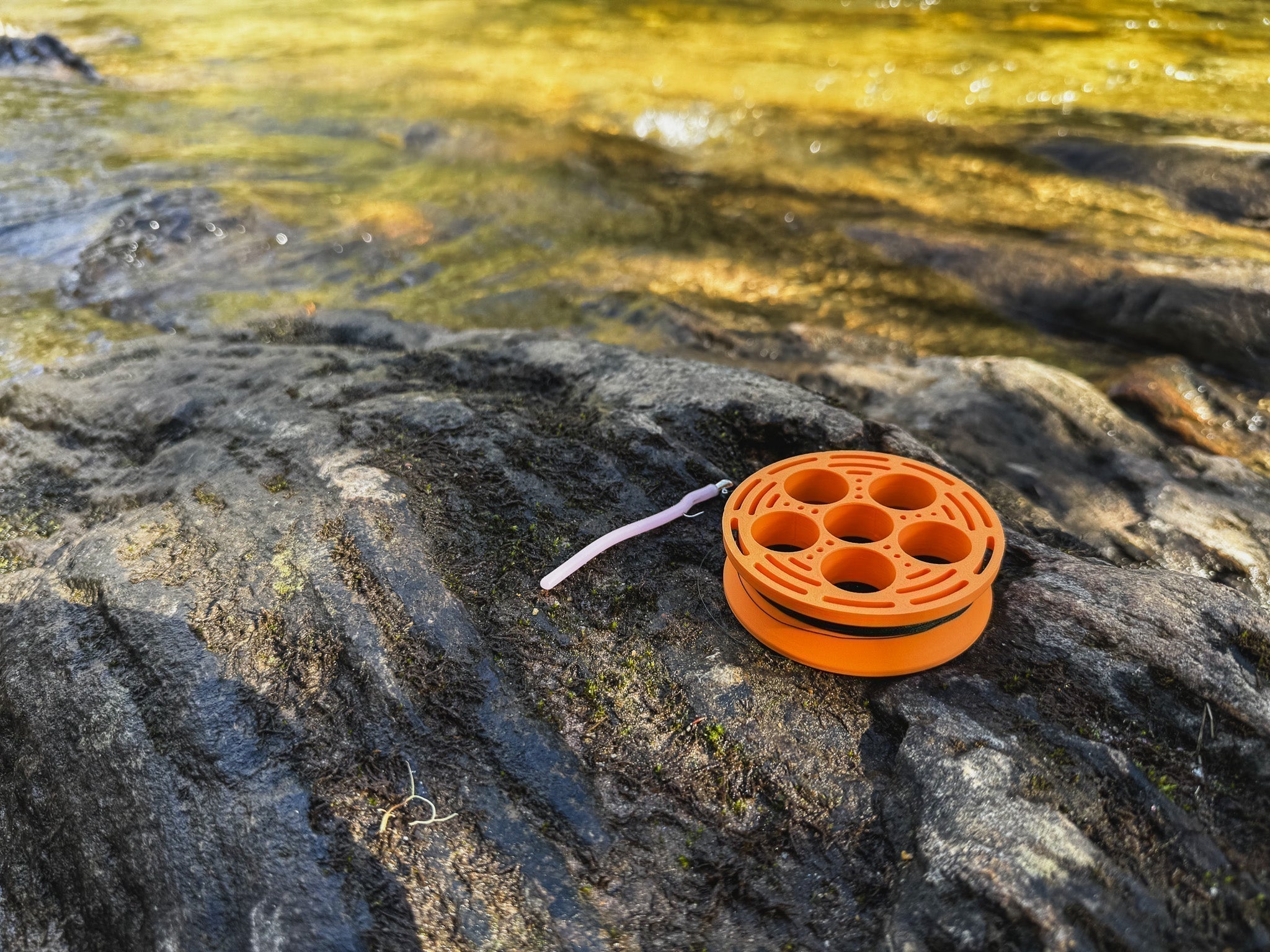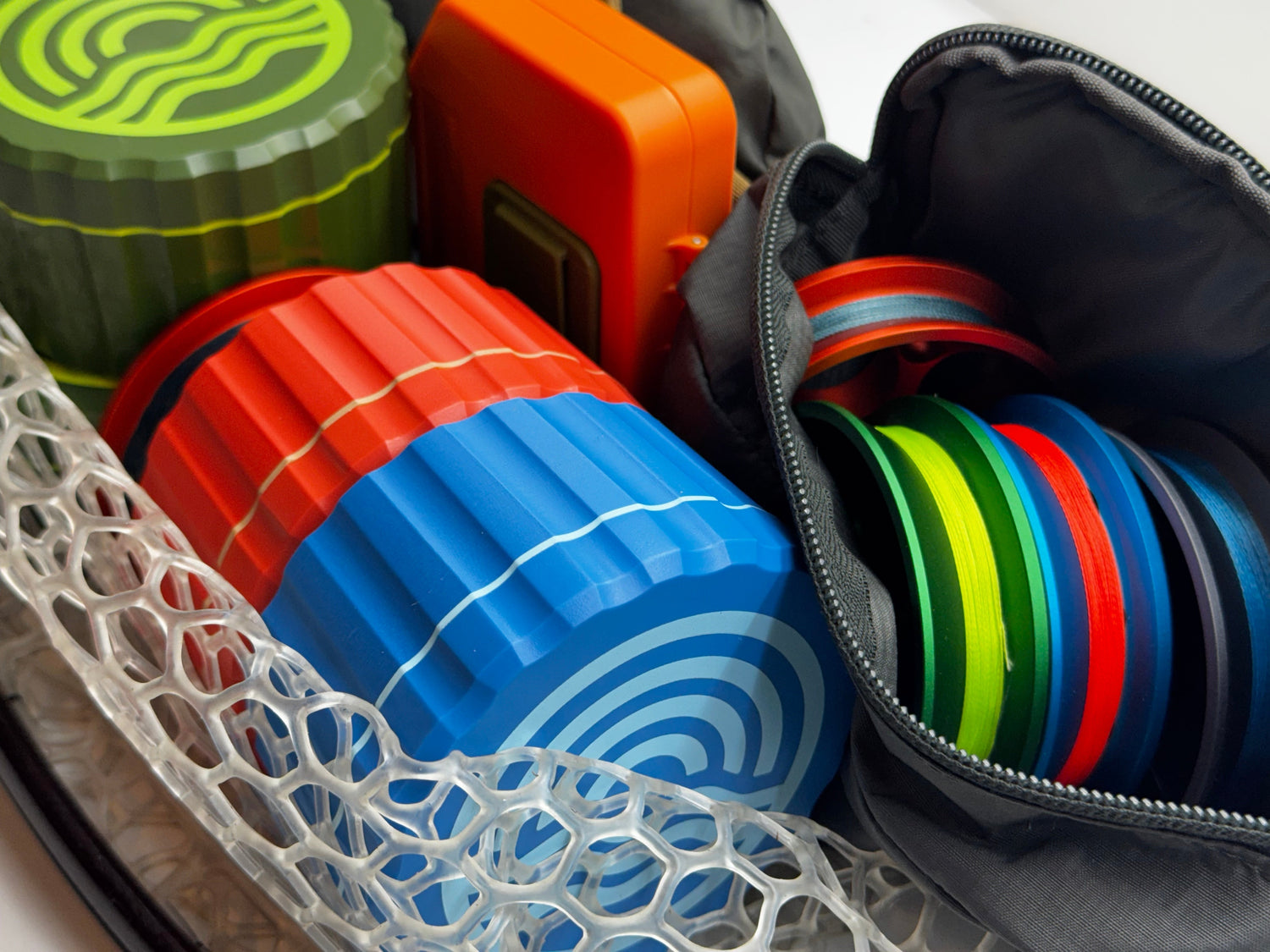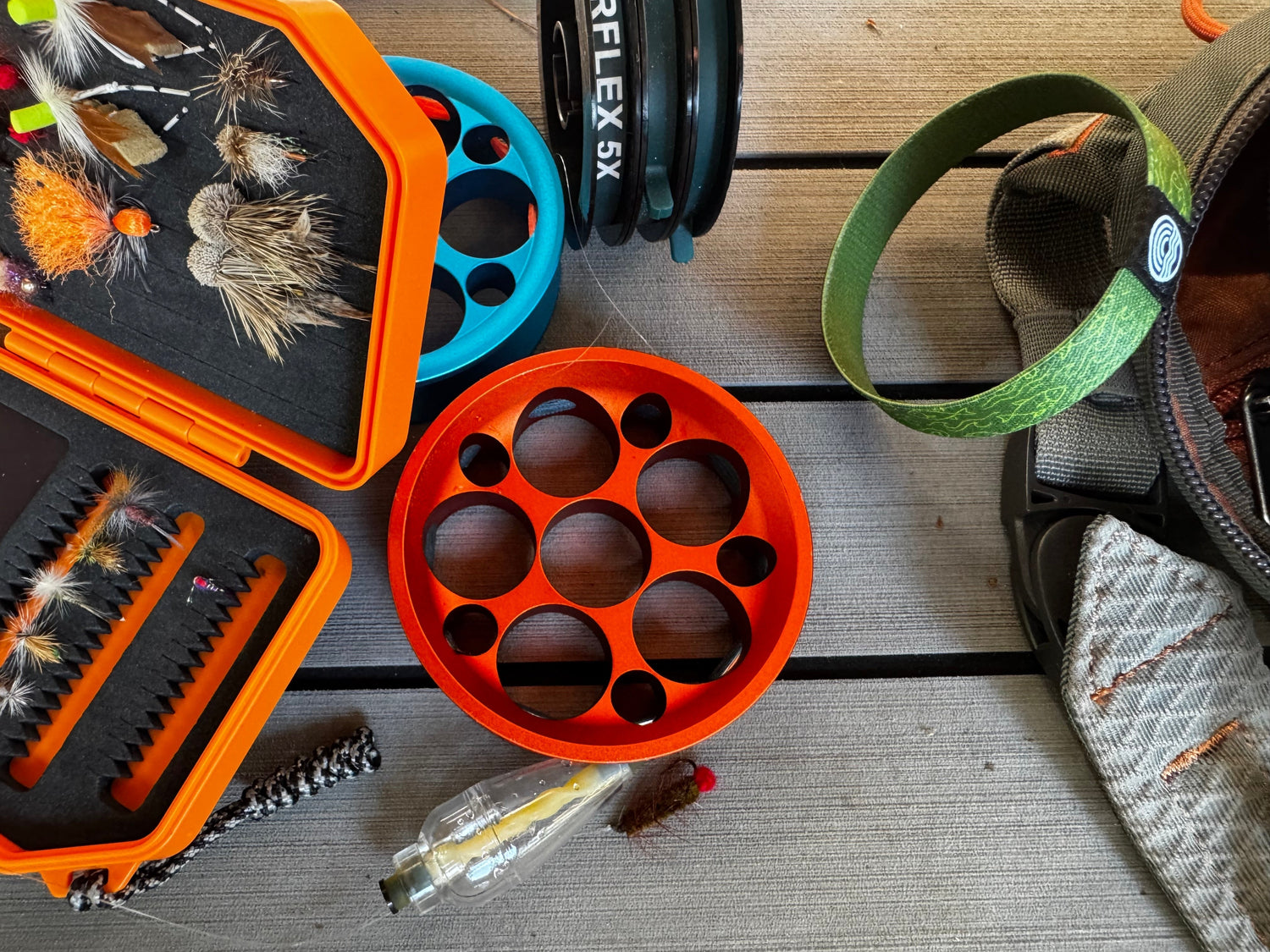Rivers are the lifeblood of the landscape, constantly moving, shaping their surroundings, and teeming with a unique array of aquatic life. For the angler, they present an enticing blend of challenge and reward. The flowing water dictates the terms, the habitats are diverse, and the fish are often wilder and warier than their stillwater counterparts. To truly connect with this dynamic environment, many anglers are turning to a simpler, more direct approach. Enter the GoReel River Fishing Kit by Crystal Creek Gear – your passport to minimalist angling adventures on flowing waters.
This compact, ingeniously designed kit embodies the spirit of minimalist fishing. It’s built for the angler who values portability without sacrificing effectiveness, who wants to be ready to cast a line at a moment's notice, whether on a dedicated fishing trip or a spontaneous riverside hike. The GoReel River Kit isn’t just about carrying less; it’s about experiencing more – more connection to your gear, more attunement to the river’s rhythms, and more of the pure joy of fishing. This article will guide you through every aspect of using your GoReel River Kit, from understanding its specialized components to mastering the art of handline fishing in currents and targeting the river’s hidden gems.
Unpacking Your GoReel River Fishing Kit: What’s Inside and Why It Matters for River Angling

The GoReel River Fishing Kit has been thoughtfully assembled to provide everything you need for a successful outing on the river, all housed in a durable, pocket-sized container. Let’s take a closer look at what makes this kit a river angler’s best friend:
- One Hand Reel: This is the heart of the GoReel system. Ergonomically designed for comfortable use, it allows for intuitive line management, casting, and retrieving. Its simplicity is its strength, offering a direct, tactile connection to your line and lure when river fishing.
- Container with Built-In Tackle Dividers: The rugged container not only protects your hand reel but also features integrated dividers. This keeps your essential tackle organized, secure, and readily accessible – no more fumbling through a bulky tackle box on the riverbank.
- Hooks & Small Tackle Container/Divider: Within the main container, a dedicated smaller section houses your hooks and other small terminal tackle, ensuring these critical items are kept separate and easy to find.
- 60 ft of Premium 15 lb Braided Fishing Line: Braided line is an excellent choice for river fishing. Its high strength-to-diameter ratio means you get a robust line that can handle surprisingly strong fish and the abrasion from rocks or woody debris, all while maintaining a thin profile that cuts through current effectively. The 15 lb test offers a good balance of strength and subtlety for most river applications with this kit.
- Premium River Fishing Tackle Kit (Curated by Leland’s Lures): Crystal Creek Gear has partnered with the experts at Leland’s Lures to include a selection of proven river performers:
- 2 Trout Magnet Worms: These soft, lifelike worms are deadly for trout and panfish. Their subtle action in the current can be irresistible.
- 3 Trout Magnets: A legendary lure, the Trout Magnet features a unique split-tail design that causes it to fall horizontally in the water, perfectly mimicking natural forage. It’s exceptionally effective in rivers for a variety of species.
- 1 Trout Slayer: Designed to imitate a fleeing crayfish or small baitfish, the Trout Slayer has a unique action that triggers aggressive strikes from bass, larger trout, and panfish in river environments.
- 3 Trout Magnet™ Jig Heads (1/64 oz): These precisely weighted jig heads are designed to give the Trout Magnets and worms the perfect fall rate and presentation in river currents. The light weight allows for a natural drift.
- 2 E-Z Floats: These small, easy-to-attach floats are invaluable for suspending your lures at a specific depth, especially when drifting through pools or slower runs. They also serve as sensitive strike indicators.
Each component in the GoReel River Kit has been chosen for its effectiveness in flowing water. The lures are designed to mimic natural river forage, the line is tough enough for river conditions, and the reel itself provides a uniquely engaging way to fish.
Target Species: What Can You Catch in Rivers with Your GoReel Kit?

Rivers are diverse ecosystems, and the GoReel River Kit, with its specialized Leland’s Lures tackle, is well-suited for targeting a variety of species. While it excels for trout fishing, its versatility extends to other common river dwellers:
- Trout (Rainbow, Brown, Brook): As the kit’s contents suggest, trout are a primary target. These fish thrive in cool, clean, well-oxygenated rivers and are suckers for the natural presentation offered by Trout Magnets and Worms. Look for them in riffles, runs, pools, and near current breaks.
- Panfish (Bluegill, Sunfish, Rock Bass, Perch): Many rivers, especially in their slower sections, eddies, or backwaters, hold healthy populations of panfish. They readily attack small lures like the Trout Magnet and can provide fast action.
- Smallmouth Bass: In warmer, rockier rivers, smallmouth bass are a prized catch. They are aggressive predators and will readily strike a well-presented Trout Slayer or even a Trout Magnet, especially when it mimics a small crayfish or minnow.
- Chub, Dace, and other Minnow Species: While not always primary targets, these smaller river fish can provide fun action on light tackle and are often found in similar habitats to trout. They are a good way to hone your handlining skills.
Understanding where these species live within a river system is key. Trout often prefer the faster, oxygenated water of riffles and runs, or the deeper, cooler water of pools. Panfish might congregate near weed beds or woody debris in slower areas. Smallmouth bass love rocky bottoms, current breaks, and submerged boulders.
Mastering River Handlining: Techniques for Your GoReel Kit
Handline fishing in a river is a uniquely engaging experience. It requires a blend of skill, finesse, and an understanding of how currents influence your lure and the fish. The GoReel makes this ancient technique accessible and highly effective.

Fundamentals of Handline Casting with the GoReel:
Casting a handline effectively with the GoReel involves a few key techniques:
- The Pendulum Cast: Hold the GoReel in one hand, and with your other hand, pull off a length of line with the lure attached. Allow the lure to swing like a pendulum. Release the line at the right point in the swing to send the lure towards your target. This is great for shorter, accurate casts.
- The Sidearm Swing/Throw: For a bit more distance, or when dealing with bankside obstructions, a sidearm swing or a gentle underhand throw can be effective. The key is a smooth motion and a well-timed release of the line you’re holding.
- Achieving Accuracy: Practice is crucial. Focus on hitting specific targets – a current seam, the edge of a rock, or an undercut bank. The direct control offered by handlining allows for very precise lure placement.
Presenting Your Leland’s Lures in River Currents:

The included Leland’s Lures are designed to shine in river conditions when presented correctly:
- Trout Magnets & Worms with Jig Heads:
- Natural Drift: This is often the deadliest technique. Cast upstream or across the current and allow your Trout Magnet or worm to drift naturally downstream, just like a dislodged insect or nymph. Maintain minimal slack in your line to detect subtle bites.
- Suspending Under an E-Z Float: In slower pools, deeper runs, or along current seams, attach an E-Z Float to suspend your lure at the desired depth. The float will also act as a strike indicator, dipping or pulling under when a fish takes the lure.
- Imparting Subtle Action: Occasionally twitch or lift the line slightly during the drift to give the lure a bit of lifelike movement.
- Trout Slayer:
- Mimicking Forage: The Trout Slayer is designed to imitate a fleeing crayfish or small baitfish. Retrieve it with short hops or a steady retrieve along the bottom, especially in areas with rocks or gravel where crayfish hide.
- Targeting Structure: Cast it into eddies, behind boulders, or along undercut banks where predatory fish like bass or larger trout might be ambushing prey.
Reading River Water: Identifying Fish-Holding Spots

Understanding how to read a river is one of the most important skills for any river angler. Look for these fish-holding spots:
- Current Breaks: Any obstruction (rocks, logs, bridge pilings) that breaks the main flow of the current creates a calmer area where fish can rest and wait for food to drift by.
- Current Seams: The edge where fast water meets slower water is a prime feeding lane.
- Eddies: Areas where the current swirls back upstream, often behind large rocks or points of land. These are resting and feeding spots.
- Pools: Deeper, slower sections of the river, often found below riffles or rapids. Fish may hold in pools for rest and security, especially larger fish.
- Undercut Banks: Areas where the current has eroded the bank, creating an overhead cover for fish.
- Riffles: Shallow, faster-moving sections with broken water. These areas are well-oxygenated and often hold insects, attracting trout.
Understanding how current affects lure presentation is also vital. A lure cast into fast water will behave differently than one in slow water. You’ll need to adjust your casting angle and retrieve to achieve the desired presentation.
Specific River Handlining Techniques for the GoReel Kit:
- Drifting (Dead Drifting): As mentioned, this is a core technique. Cast upstream and let your lure tumble naturally with the current, keeping in contact with it as much as possible.
- Swinging: Cast across the current (or slightly upstream) and let the line tighten as the current sweeps your lure downstream in an arc. This is effective for covering water and can trigger strikes as the lure changes direction.
- Bottom Bouncing (with care): If targeting bottom-dwelling species or trying to get deep in faster currents, you can allow your jig to tap along the bottom. Be mindful of snags, especially with light tackle.
- Using E-Z Floats Effectively: Adjust the depth of your float based on where you think the fish are holding. In varied currents, you may need to mend your line (reposition it on the water’s surface) to ensure a drag-free drift for your float and lure.
Line Management and Bite Detection in Flowing Water:
With a handline, you are the drag system and the bite detector. Keep a slight tension on the line to feel for subtle takes, which can feel like a slight tick, a change in pressure, or the line stopping unexpectedly. Braided line excels here due to its low stretch and sensitivity.
Setting the Hook and Fighting Fish in a Current:
When you detect a bite, a short, quick upward or sideways pull of the line is usually enough to set the hook, especially with sharp Trout Magnet jig heads. When fighting a fish in a current, use the river’s flow to your advantage when possible. Be prepared for the fish to use the current to its advantage too! Apply steady pressure, and be ready to give line if a larger fish makes a strong run. The 15lb braided line provides a good safety margin.
Maximizing Your Success on the River with the GoReel
Beyond the core techniques, a few additional considerations can elevate your river fishing game:
- Stealth and Approach: Rivers, especially smaller ones or those with clear water, demand a stealthy approach. Move slowly and quietly along the bank. Wear drab clothing to blend in. Use bankside vegetation or boulders for cover. Avoid letting your shadow fall over likely fish-holding spots.
- Adapting to Water Conditions: River conditions can change rapidly. Pay attention to water clarity (murky water may require brighter lures or more vibration), flow rate (higher flows may require slightly heavier presentations or different casting angles), and water temperature (which affects fish activity levels).
- Wading Safely and Effectively: If you choose to wade, always use a wading staff for stability, wear appropriate footwear with good traction (felt or sticky rubber soles), and shuffle your feet to avoid tripping. Never wade in water that is too deep or too fast for your capabilities. A wading belt is a crucial safety item.
- Understanding River Etiquette and Conservation: Respect other anglers by giving them space. Practice catch and release carefully, especially with wild trout, to ensure healthy fish populations for the future. Know and follow all local fishing regulations.
Safety and Best Practices for River Fishing
Rivers can be unpredictable environments. Prioritize safety on every outing:
- Be Aware of Changing Conditions: Check weather forecasts and be mindful of rising water levels, especially after rain.
- Proper Footwear and Attire: Sturdy, waterproof boots with good traction are essential. Dress in layers appropriate for the weather.
- Handling Fish with Care: If practicing catch and release, wet your hands before handling fish to protect their slime coat. Minimize the time the fish is out of water. Use forceps or your GoReel’s small tackle divider to quickly remove hooks.
- Leave No Trace: Pack out everything you pack in. Leave the riverbank cleaner than you found it. Minimize your impact on vegetation and wildlife.
Your River Adventure Awaits with GoReel
The GoReel River Fishing Kit is more than just a collection of tackle; it’s an invitation to experience river fishing in its purest, most engaging form. Its portability means you’re always ready for an adventure, its simplicity fosters a deeper connection with the angling process, and its carefully selected components give you a genuine edge in diverse river environments. Whether you’re a seasoned angler looking to pare down your gear or a newcomer drawn to the allure of flowing waters, the GoReel River Kit provides the tools and the inspiration to master the current.
So, pack your GoReel, find a stretch of river that calls to you, and immerse yourself in the timeless pursuit of fish in flowing water. The river’s secrets are waiting to be unlocked, one cast at a time.





